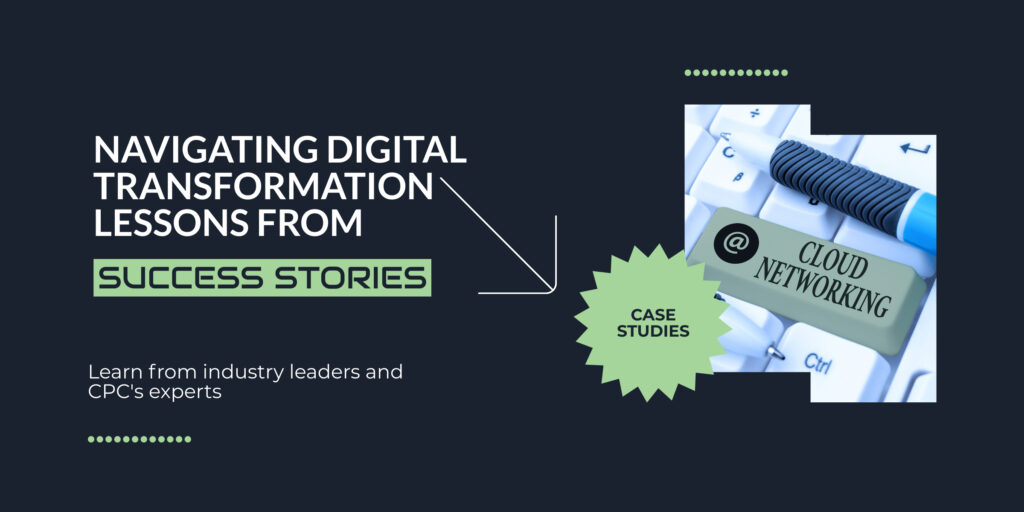Understanding the Essence of Digital Transformation
Digital transformation involves integrating digital technology into all areas of a business, fundamentally changing how you operate and deliver value to customers. This process is not just about upgrading your IT infrastructure; it represents a significant cultural shift that requires organizations to rethink and redefine how they engage with their customers and employees. It necessitates a willingness to innovate and adapt to emerging technologies while fostering a more agile and responsive organizational culture.
Companies like Netflix and Amazon have set the benchmark for digital transformation through their strategic approaches and relentless pursuit of innovation. For instance, Netflix’s evolution from a DVD rental service to a leading streaming giant illustrates the importance of foresight and adaptability in a rapidly changing market. This journey reflects not only a shift in how content is consumed but also a deep understanding of audience preferences and behaviors, enabling Netflix to produce original content that resonates with viewers.
Similarly, Amazon’s relentless focus on customer experience demonstrates the power of digital tools in crafting personalized interactions. By leveraging advanced data analytics and artificial intelligence, Amazon continually refines its offerings, recommending products tailored to individual preferences and streamlining the shopping experience. This commitment to utilizing technology to enhance customer satisfaction has solidified Amazon’s position as a leader in the e-commerce space.
Ultimately, digital transformation is a multi-faceted journey that goes beyond technology; it requires a holistic approach that embraces a new way of thinking, fosters innovation, and prioritizes customer-centric strategies. Organizations that successfully navigate this transformation will not only improve their operational efficiency but also create lasting value for their customers and stakeholders.
Why Businesses Must Transform Digitally
Businesses that resist digital change risk being eclipsed by more agile competitors. Digital transformation enables companies to streamline operations, enhance customer engagement, and drive innovation. It’s about using technology to achieve business goals more efficiently and effectively.
The COVID-19 pandemic accelerated the need for digital solutions, highlighting weaknesses in traditional business models. Organizations that had already embraced digital transformation were better equipped to pivot and adapt, underscoring its critical role in resilience.
Key Drivers of Digital Transformation
Several factors drive the need for digital transformation. Technological advancements, changing consumer expectations, and competitive pressures are at the forefront. Customers today demand seamless, personalized experiences, which can only be delivered through digital means. Additionally, the rise of big data and AI has opened new avenues for insight-driven decision-making.
An article published by Yenlo states Siemens launched their global RPA (Robotic Process Automation) center of excellence in 2017 signaling this transition. The ever-nimble company accomplished its 2020+ vision, with a 28% YOY profit increase and a 16% stock price surge, all amid a pandemic, echoing its triumph. “The tech overhaul fortified Siemens’ position, allowing the company to explore growth avenues while efficiently trimming excess.” The key is not just adopting new technologies but integrating them into your overall business strategy in a way that enhances your operations and drives growth. This involves understanding how these technologies can streamline processes, improve customer experiences, and create new opportunities for innovation. By thoughtfully incorporating technology, businesses can not only keep up with the competition but also position themselves for long-term success in an ever-evolving market.
Key Drivers of Digital Transformation: Insights from Cornerstone Paradigm Consulting’s Case Study on Remote Contact Centers
One of our case studies highlights a remote contact center with several key drivers of digital transformation within this specific context. One primary driver was the necessity for enhanced operational flexibility. As this organization transitioned to a 95% remote workforce, the ability to seamlessly integrate digital tools and platforms became essential for maintaining productivity and service levels. We emphasize the importance of customer experience, noting how contact centers leveraging digital technologies can deliver more responsive and personalized support, ultimately fostering stronger customer relationships. This client capitalized on upgrading their CCaaS system and stacking it with their current CRM system to streamline the customer onboarding process and clean up customer data.
Another significant factor identified is the drive for cost efficiency. By implementing advanced technologies such as a cloud-based CCaaS systems and AI-powered chatbots, this company reduced overhead costs typically associated with traditional contact center operations while improving response times. Moreover, data analytics played a crucial role in this transformation, enabling the company to gain insights into customer interactions, optimize workflows, and inform strategic decision-making.
These factors emphasize the urgent need for organizations to embrace a digital-first mindset in response to changing market dynamics and shifting consumer expectations.
Building a Digital-First Culture: Adobe
Adobe Systems Incorporated stands as a prime example of a company that has successfully cultivated a digital-first culture. Over the past decade, Adobe transformed its business model from selling perpetual software licenses to embracing a subscription-based model with Adobe Creative Cloud. This shift not only revolutionized its revenue model but also fostered a culture of continuous innovation and responsiveness to customer needs.
By prioritizing user feedback and leveraging data-driven insights, Adobe has consistently enhanced its product offerings. The company employs a “Customer-First” philosophy, ensuring that every product development decision is rooted in understanding the evolving requirements of its diverse user base. This approach has led to the introduction of collaborative tools such as Adobe XD, which empower teams to work together in real-time, thereby promoting agility and creative collaboration.
Moreover, Adobe’s commitment to digital marketing and analytics has allowed it to track user engagement effectively, enabling quick iterations and enhancements based on real-time data. As a result, Adobe not only boasts a loyal customer base but has also achieved significant growth in subscription revenues, demonstrating the success of a robust digital-first culture that prioritizes innovation and customer-centric strategies. This transformation underscores the potential for traditional companies to thrive by adopting a digital-first mindset, paving the way for sustained success amid the ever-changing technological landscape.
Overcoming Resistance to Change: The Case of Ford Motor Company
A notable example of successfully overcoming resistance to change is Ford Motor Company’s strategic shift under the leadership of former CEO Alan Mulally. Faced with significant financial challenges and a declining market share in the mid-2000s, Mulally implemented the “One Ford” plan, which aimed to unify the company’s global operations, streamline product offerings, and foster a culture of collaboration.
To address the internal resistance that often accompanies substantial change, Mulally focused on open communication and transparency, ensuring that employees at all levels understood the vision and goals behind the transformation. By promoting a sense of shared purpose, he was able to rally his workforce around the initiative. Mulally also emphasized the importance of teamwork and accountability, establishing cross-functional teams to enhance innovation and efficiency.
As a result of these efforts, Ford not only turned around its financial performance, reporting consistent profitability and gaining market share but also rejuvenated its corporate culture. The success of the “One Ford” initiative exemplifies how effective leadership, clear communication, and a focus on collaboration can help overcome resistance to change, ultimately positioning an organization for long-term success in a competitive industry.
Leveraging Technology for Business Growth
Digital transformation goes beyond the mere adoption of new technologies; it involves a strategic approach to utilizing these tools to drive substantial business growth. In today’s rapidly evolving business landscape, technologies such as cloud computing, artificial intelligence, the Internet of Things (IoT), and blockchain present a myriad of opportunities for organizations looking to enhance their operations.
These technologies can significantly improve efficiency by automating processes, which reduces the likelihood of human error and allows employees to focus on higher-value tasks. Additionally, they can help cut costs through improved resource management and streamlined workflows. For instance, cloud computing enables businesses to optimize their IT resources, while AI can analyze vast amounts of data to uncover insights that drive decision-making.
Furthermore, by embracing these innovations, businesses can create new revenue streams through novel products and services tailored to meet changing customer demands. IoT devices can gather real-time data that informs product development, while blockchain can enhance transparency and security in transactions, fostering trust with customers.
Delivering exceptional customer experiences is also paramount in digital transformation. Leveraging technology to personalize interactions and streamline service delivery can lead to increased customer satisfaction and loyalty.
The key to successful digital transformation lies in aligning technology investments with overarching business objectives. It’s crucial for organizations to ensure that their technological advancements not only address immediate challenges but also contribute to their long-term growth and success. By doing so, businesses will be better positioned to navigate the complexities of the modern marketplace and achieve sustainable competitive advantage.
Case Study: Cornerstone Paradigm Consulting’s Transformation Strategy
CPC demonstrates how strategic transformation can enhance operational efficiency and provide a competitive edge. In one of our case studies, we detail a successful project with a retail client facing challenges in inventory management and supply chain visibility. By implementing a comprehensive digital solution that integrated real-time data analytics with cloud-based inventory systems, we achieved significant improvements in stock management and forecasting accuracy through a stacked WMS and ERP solution.
This transformation not only reduced excess inventory by 30% within the first year but also increased order accuracy and customer satisfaction levels. By harnessing the power of technology, we enabled the client to respond more swiftly to market changes, effectively streamlining operations and fostering a data-driven decision-making culture. This case underscores the importance of leveraging tailored technology solutions to address specific business challenges and drive meaningful results in today’s competitive landscape.
Harnessing Data for Better Decision-Making
Data is a powerful asset in business. Organizations that can harness data effectively gain a significant competitive edge. By collecting and analyzing data, businesses gain insights into customer behavior, market trends, and operational performance, enabling data-driven decision-making.
Effective data management involves setting up robust systems for data collection, storage, and analysis, ensuring data integrity and security. It also requires fostering a data-centric culture where employees at all levels are empowered to use data in their daily decision-making processes.
Companies that continue to rely on compartmentalized systems and patchwork data solutions are not only missing out on potential revenue but also failing to gain a comprehensive understanding of their operations.
Personalizing Customer Experiences
Personalization is a key driver of customer satisfaction and loyalty. Digital transformation enables businesses to tailor their offerings to individual customer preferences, creating personalized experiences that resonate with their audience.
By leveraging data analytics and AI, organizations can gain insights into customer behavior and preferences, allowing them to deliver targeted marketing campaigns, personalized product recommendations, and tailored customer support.
Case Studies of Successful Digital Transformations
Examining real-world examples of successful digital transformations provides valuable insights into best practices and potential pitfalls. Companies like Starbucks, General Electric, and Domino’s have demonstrated how digital transformation can drive growth and improve customer engagement.
Starbucks’ integration of digital payments and loyalty programs revolutionized the customer experience, leading to increased sales and customer retention. General Electric’s use of IoT and data analytics transformed its industrial operations, enhancing efficiency and reducing costs. Domino’s embraced online ordering and mobile apps, significantly increasing its market share and brand loyalty.
Lessons Learned from Industry Leaders
Successful digital transformations share common themes, including strong leadership, a clear vision, and a focus on customer-centricity. Industry leaders emphasize the importance of aligning digital initiatives with business goals and continuously iterating to adapt to changing market conditions.
They also highlight the need for agility, enabling organizations to respond quickly to emerging opportunities and challenges. By fostering a culture of innovation and collaboration, companies can stay ahead of the curve and drive sustainable growth.
Avoiding Common Pitfalls
Despite the potential benefits, digital transformation can be fraught with challenges. Common pitfalls include a lack of clear strategy, insufficient resources, and resistance to change. To avoid these pitfalls, organizations should establish a clear roadmap, allocate adequate resources, and engage employees throughout the process.
By setting realistic expectations and continuously monitoring progress, businesses can mitigate risks and ensure that their digital transformation efforts deliver the desired outcomes.
The Future of Digital Transformation
The digital landscape continues to evolve, presenting new opportunities and challenges for businesses. Emerging technologies such as AI, machine learning, and blockchain are set to play an increasingly significant role in shaping the future of digital transformation.
Organizations that can adapt to these changes and leverage new technologies strategically will be well-positioned to thrive in the digital age. The future of digital transformation will require continuous innovation, collaboration, and a relentless focus on delivering value to customers.
Preparing for the Next Wave of Innovation
To stay ahead of the competition, businesses must be proactive in preparing for the next wave of digital innovation. This involves staying informed about emerging trends and technologies, investing in research and development, and fostering a culture of continuous learning and improvement.
By anticipating future trends and positioning themselves as early adopters, organizations can seize new opportunities and maintain their competitive edge.
Staying Ahead in a Digital World
By leveraging technology to enhance customer experiences, drive operational efficiency, and foster innovation, organizations can achieve sustainable growth and success.
To stay ahead, businesses must continuously evaluate their digital strategies, adapt to changing market dynamics, and invest in the tools and technologies that will drive their future success.
By learning from successful transformations and leveraging technology strategically, organizations can enhance their operations, improve customer experiences, and achieve sustainable growth.
The lessons outlined in this article provide valuable insights for business leaders looking to embrace digital change. By prioritizing digital initiatives and fostering a culture of innovation and collaboration, organizations can position themselves for long-term success. Get started today with one of our industry experts.







